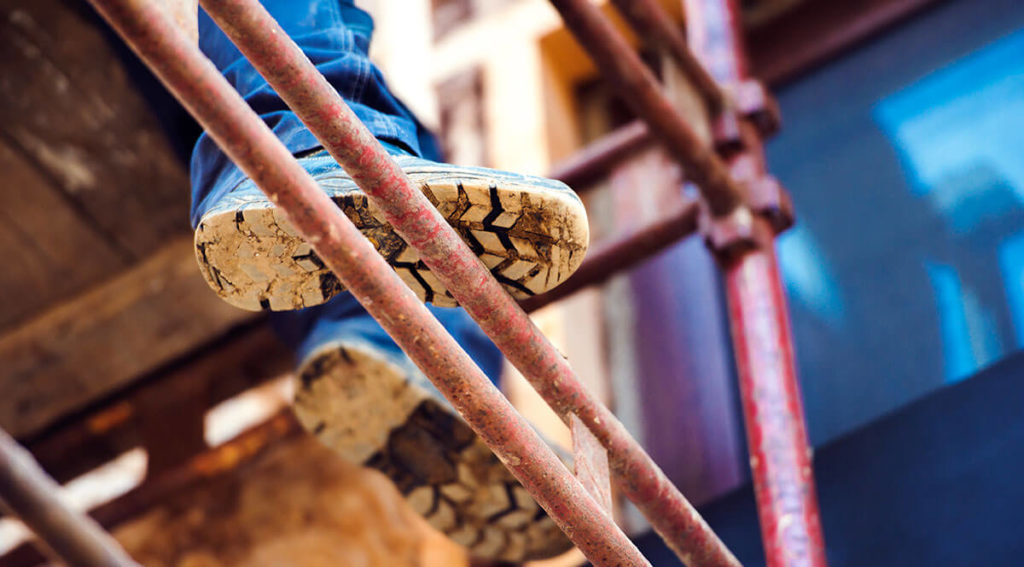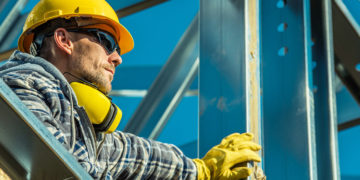NYC Scaffolding Accident Prevention Guide

At any given construction site, you’ll find scaffolds as part of the landscape. Designed as temporary structures, scaffolds enable construction companies to gain access to higher levels of buildings and serve as platforms for both the site’s workers and materials they need to get the job done.
According to the U.S. Occupational Safety and Health Administration (OSHA), 65% of the construction workforce in the U.S., or 2.3 million construction workers, work on scaffolds. With this high number of workers using scaffolds, unfortunately, the number of deaths and injuries are also higher than in other industries.
The New York City Department of Vital Signs tracks the number of injuries and deaths occurring in the construction industry and the agency reports falls comprise 58% of fatal unintentional injuries among the city’s construction workers. It’s significant to note 25% of these occurred from scaffolds. Additionally, NYC’s Vital Signs officials reported “at least one serious safety violation” was cited in over 90% of OSHA’s fatality investigations—scaffolding accidents accounted for more than 20 of the 91 incidents reported in the city from 2007-2014.
Types of accidents common when using scaffolding structures include:
- Slips and falls
- Falling objects
- Flooring and plank collapses
- Faulty set up of scaffolding creating various hazardous situations
Sadly, many accidents involving scaffolds are preventable but construction companies, often due to budget or deadline pressures, sometimes fail to put the proper mechanisms in place to prevent accidents. OSHA reports indicate had adequate safety measures been put into place, many of the annual 4,500 injuries and 60+ deaths per year could have been prevented.
Understanding Scaffolding Safety Regulations and Standards
Strict requirements for scaffold use are established by both state and federal regulations. Construction companies are supposed to follow specific criteria designed to maximize safety for both workers and passersby. They also must take into consideration the type of scaffolding being used at the construction site.
- Safe access must be provided at all levels of access on a scaffold.
- Planking must be able to support its own weight times, plus four times (or more) of the intended load.
- Routine inspections of scaffolds and riggings must take place before each shift.
- Work is not allowed on scaffolds littered with debris.
- Erection of scaffolds must be a minimum of 10 feet from electrical power lines.
- Any steps and landings added to the scaffold must have nonslip treads and guardrails, along with stable and level footing.
- A supervisor must be informed before scaffolds are built, moved, dismantled, or altered in any way.
- Employees must be trained by a qualified individual to recognized scaffold-related hazards and to learn how to control or minimize these hazards. This includes any hazards associated with falls, falling objects, electrical use, material handling, and how to use scaffolds properly.
- Scaffolds must be properly and securely attached to building facades.
- Any accessories used in conjunction with scaffolds, including ropes and ladders, must be in good working order—if any equipment is damaged, it should be fixed or replaced immediately.
- Canopies and safety netting should be used as necessary to protect workers and passerby from potentially falling objects.
Additionally, larger scaffolds may be subjected to additional inspections by a professionally trained and certified engineer.
Staying Safe Around Scaffolds
People who work on, near, under, or pass by scaffolds should always be aware of the hazards that tend to accompany scaffold use. At any construction site, an unexpected event, such as a dropped item or unexpected slip can occur. If you take precautions, you can increase the safety of yourself and/or those around you.
- Always wear a hardhat when working in any construction area, including scaffolds.
- Make the extra effort to set up scaffolds as designed, do not take short cuts, and be sure to inspect after each erection.
- If scaffolds are covered in snow, ice, or other slip hazards have been spilled, do not use until it has been properly cleared or cleaned.
- Never place objects, such as free-standing ladders or boxes, on scaffolds because these can tip and create a dangerous situation.
- Use mounted ladders and be sure to follow all safety instructions accompanying their use.
- Never use short-cuts when climbing on a scaffold, stick to designated methods of access.
- Always be aware of your surroundings when working on or near a scaffold.
- Tell a supervisor of any potential safety violations or concerns—even if you’re not sure, it’s better to be safe than sorry.
Employers are required to provide adequate fall prevention for employees when working on scaffolds higher than 10 feet. This includes safety netting, guardrails (OSHA states steel or plastic bandings cannot be used as a toprail or midrail), toeboards, and fall arrest systems.
Proper Scaffold Training Is Essential
Training is a necessary factor in accident prevention at construction sites. Workers using or working in the vicinity of scaffolds should receive routine training to learn best practices that include the following.
- Understanding any potential hazards associated with scaffolds.
- Procedures to safely use scaffolds.
- How to properly and safely relocate portable scaffolds.
- Learning how to take protective measures when working with scaffolding.
- Understanding load capacities associated with the different types of scaffolds used at construction sites.
- How to identify any defects associated with scaffolds.
Employers should angle training to the specific scaffolds used at each construction site. If changes on the site occur, workers should be updated with new training so they understand any hazards and safety considerations associated with the new situation. New York has specific laws associated with scaffold safety. Including labor law 200, 240, and 241. Many scaffolding accidents are avoidable and, unfortunately, companies often take shortcuts without regard for their workers or others in the vicinity of work sites.
What If A Scaffolding Accident Happens?
If you or a loved one have been injured, or if you’ve suffered the loss of someone dear to you, due to a scaffolding-related accident, you deserve justice for your pain and suffering.
“The knowledgeable and compassionate attorneys at O’Dwyer & Bernstien have been fighting for the rights of New Yorkers for over a century. They’ll actively work to preserve your rights. If you would like to learn more about construction accidents, call our office today for a free consultation about your case.”
Brian O’Dwyer, Construction Accident Lawyer – O’Dwyer & Bernstien



